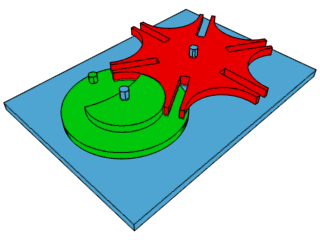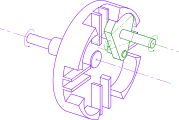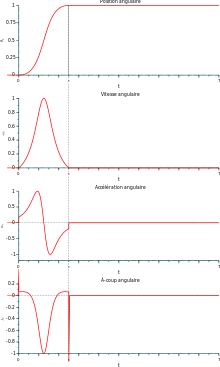Geneva drive

The Geneva drive or Maltese cross is a gear mechanism that translates a continuous rotation into an intermittent rotary motion. The rotating drive wheel has a pin that reaches into a slot of the driven wheel advancing it by one step. The drive wheel also has a raised circular blocking disc that locks the driven wheel in position between steps.
Background
The name derives from the device's earliest application in mechanical watches, Geneva, Switzerland being an important center of watchmaking. The Geneva drive is also commonly called a Maltese cross mechanism due to the visual resemblance when the driven wheel has four spokes. Since they can be made small and are able to withstand substantial mechanical stress, these mechanisms are frequently used in watches.
In the most common arrangement, the driven wheel has four slots and thus advances by one step of 90 degrees for each rotation of the drive wheel. If the driven wheel has n slots, it advances by 360°/n per full rotation of the drive wheel.

Because the mechanism needs to be well lubricated, it is often enclosed in an oil capsule.
Uses and applications
One application of the Geneva drive is in movie projectors: the film does not run continuously through the projector. Instead, the film is advanced frame by frame, each frame standing still in front of the lens for 1/24 of a second (and being exposed twice in that time, resulting in a frequency of 48 Hz). This intermittent motion is achieved using a Geneva drive. (Modern film projectors may also use an electronically controlled indexing mechanism or stepper motor, which allows for fast-forwarding the film.) The first uses of the Geneva drive in film projectors go back to 1896 to the projectors of Oskar Messter and Max Gliewe and the Teatrograph of Robert William Paul. Previous projectors, including Thomas Armat's projector, marketed by Edison as the Vitascope, had used a "beater mechanism", invented by Georges Demenÿ in 1893, to achieve intermittent film transport.
Geneva wheels having the form of the driven wheel were also used in mechanical watches, but not in a drive, rather to limit the tension of the spring, such that it would operate only in the range where its elastic force is nearly linear. If one of the slots of the driven wheel is occluded, the number of rotations the drive wheel can make is limited. In watches, the "drive" wheel is the one that winds up the spring, and the Geneva wheel with four or five spokes and one closed slot prevents overwinding (and also complete unwinding) of the spring. This so-called Geneva stop or "Geneva stop work" was the invention of 17th or 18th century watchmakers.
Other applications of the Geneva drive include the pen change mechanism in plotters, automated sampling devices, indexing tables in assembly lines, tool changers for CNC machines, banknote counting and so on. The Iron Ring Clock uses a Geneva mechanism to provide intermittent motion to one of its rings.
A Geneva drive was used to change filters in the Dawn mission framing camera used to image the asteroid 4 Vesta in 2011. It was selected to ensure that should the mechanism fail at least one filter would be usable.[1]
Internal Geneva drive
An internal Geneva drive is a variant on the design. The axis of the drive wheel of the internal drive can have a bearing only on one side. The angle by which the drive wheel has to rotate to effect one step rotation of the driven wheel is always smaller than 180° in an external Geneva drive and always greater than 180° in an internal one, where the switch time is therefore greater than the time the driven wheel stands still.
-

Internal Geneva drive.
-

Animation showing an internal Geneva drive in operation.
The external form is the more common, as it can be built smaller and can withstand higher mechanical stresses.
Spherical Geneva drive
Another variant is the spherical Geneva drive.[2]
-

Spherical Geneva drive.
Kinematics

The figure shows the motions curves for an external four-slots Geneva drive, in arbitrary units. There is a discontinuity in the acceleration when the drive pin enters and leaves the slot. This generates an "infinite" peak of jerk (Dirac peak), and therefore vibrations.
See also
- Dwell cam
References
- ↑ "Camera", Multimedia (Mov) (moving pictures), US: Jet propulsion laboratory, Nasa.
- ↑ Bickford, John H. (1972). "Geneva Mechanisms". Mechanisms for intermittent motion. New York: Industrial Press inc. 128. ISBN 0-8311-1091-0.
Further reading
- Sclater, Neil (2011), "Cam, Geneva, and Ratchet Drives and Mechanisms", Mechanisms and Mechanical Devices Sourcebook (5th ed.), New York: McGraw Hill, pp. 180–210, ISBN 978-0-07170442-7. Drawings and designs of various drives.
External links
| Wikimedia Commons has media related to Geneva drive. |
- The Geneva wheel (tutorial), Cornell.
- The Geneva stop, UNL.
- External Geneva drive (animation), Brock eng.
- U.S. Patent 6,183,087 – Quickermittent. Modified starwheel for fast pulldown.
- "LEGO Geneva Mechanism", Brick engineer (animation and instructions for building), Oct 7, 2007